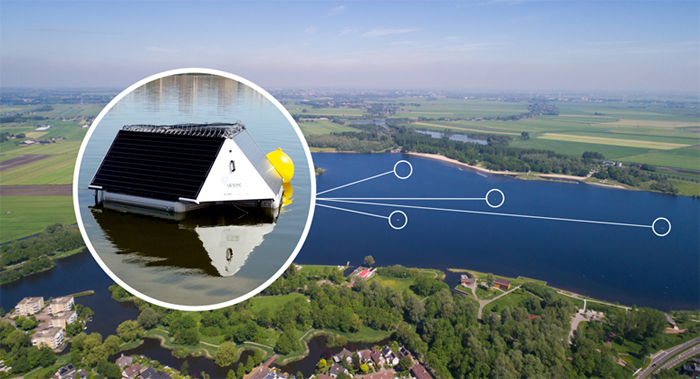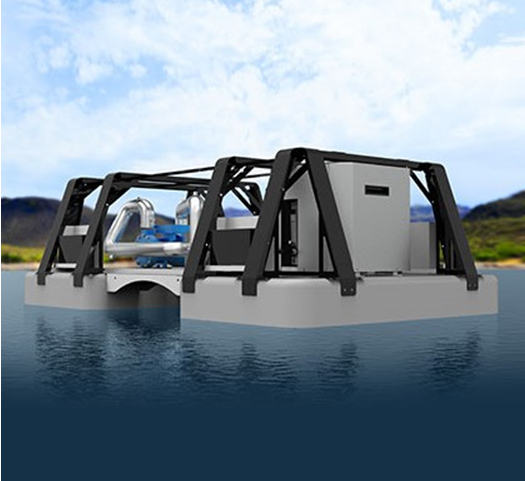|
|

|
  
Feature
Update 2019/11/18
Blue-green algae
brought to you in part by

LG SONIC – REMOVING TOXIC ALGAL BLOOMS SAFELY AND SUSTAINABLY
By Suzanne Forcese
Microscopic algae are an important part of the ecosystem. However, its massive growth and the production of toxins can suffocate aquatic life and endanger our drinking water supplies. Rising temperatures, extreme weather, stagnant water, chemicals from wastewater treatment, and excess nutrients from agricultural run-off accelerate algal growth. More than 60% of our global water is contaminated.
A new environmentally friendly solution, developed in The Netherlands, by LG Sonic, is able to eliminate up to 90% of algal blooms using big data and ultra sound (MPC) technology to Monitor, Predict and Control algal blooms. The Dutch company’s mission lies in helping the ecosystem’s recovery without harm to aquatic life, livestock and people.
On November 4, 2019, LG Sonic was awarded the Aquatech Innovation Award in the category of water supply, at the Amsterdam International Water Week. Lisa Marie Brand, CTO of LG Sonic, said about the latest safe and sustainable solution for algal blooms, (the MPC-NanoBubble), “This brings our company one step closer to eliminate the usage of harmful chemicals in water treatment.”
WaterToday had the pleasure of interviewing Brand, Chief Technology Officer, who has been with the company for 10 years following her microbiology studies. “Our mission has always been to reduce or eliminate harmful chemicals in the environment,” Brand told WT.
The company has several algae control and biofouling control product lines, “But we primarily focus on applications in large surface water such as lakes, hydroelectric dams and reservoirs.” The MPC-Buoy has a treatment range of 500 metres in diameter. A complete overview of the water quality is provided by collecting parameters such as dissolved oxygen, pH, temperature, turbidity, chlorophyll a (green algae), and phycocyanin (blue-green algae).
The collected data is delivered in real-time via radio, GPRS, or 3G to web-based software. Based on the received information, ultrasonic transmitters are activated and/or optimized. Most of the lakes we treat use a set of these MPC-Buoy systems to cover the entire lake surface.”

Several MPC-Buoys on a lake surface. Photo courtesy LG Sonic
Algae rely on their buoyancy to remain close enough to the water surface to collect sunlight for their growth. “To control algae, The MPC-Buoy system transmits specific ultrasound waves that create a sound layer in the top layer of the water. This affects the buoyancy of the algae, preventing them from rising to the surface and absorbing light for photosynthesis. Due to the lack of sunlight and nutrients, the algae sink to the bottom of the reservoir and are degraded by the bacteria present. The algae will die while the cell wall remains intact, preventing the sudden release of toxins from the algae into the water.”
LG Sonic has worked with several European Universities over the years to determine the mechanisms behind the control of algal blooms. The in-house team of over 30 also includes several scientist researchers in The Netherlands, the UK and the USA. “We all share the values of creating something that is sustainable and helps solve pollution.”
The ultrasound used by LG Sonic is low (5-20 Watts) making it safe for fish, plants, zooplankton and insects. The process is not based on cavitation, which is a phenomenon where high-powered ultrasound causes the formation of micro-bubbles that implode, causing intense heat pressure. That process can destroy cells and harm fish and plants.
“We have worked with different water bodies of several square kilometres in size. The largest is around 12 sq. km. Currently we have more than 10,000 installations in 54 countries.”
Could this technology be applied to larger bodies of water such as Lake Erie and Lake Winnipeg where algal blooms are extremely serious? “What we can do in these situations is get a better understanding of how the blooms form and move through the lake and where they are causing the most problems. Part of this research can be done in-house as well. Our scientists hold different skill sets such as remote sensing (where we use satellite data to calculate the concentration of algae spread over an entire surface area). By working with different images on different time intervals we can calculate how blooms move through the water. This information is also used to feed our algorithms to predict algal blooms. This can, in turn, be used for the analyses of a proper solution for parts of these lakes.”
Proper solutions keep evolving. Broadening their mission to develop a chemical-free technology that controls the algae without disturbing the natural balance within water ecosystems, LG Sonic introduced the Award-Winning MPC- NanoBubble, at the recent International Water Week in Amsterdam.
“LG Sonic realized that through our already existing knowledge on the use of data and real-time water-quality, monitoring was key in the upscaling of nano-bubble technologies for lakes. Through the MPC-Buoy we could already control the algae and therefore offer relief to the ecosystem in the form of increasing the clarity of the water, allowing benthic plants to photosynthesize again and reducing pH levels. However, the MPC-NanoBubble is a key element that will help reduce the effect of toxic components and nutrients to be released from the sediment while restoring beneficial bacterial colonies in the sediment that are important to bring a water body back into balance.”

MPC-Nanobubble is the only system in the world that moves autonomously through a waterbody to oxygenate a lake in its entirety. Photo Courtesy LG Sonic
Anoxia occurs when water bodies are depleted of dissolved oxygen. In these conditions fish can suffocate and die. Further there is a risk of potentially harmful components -- such as phosphorus, heavy metals, and manganese -- being released from the sediment. “We have always been specifically interested in the nanobubble technology because it does not necessarily de-stratify or move the water column. This, in our opinion, is better for the ecosystem, but consumes too much energy, deeming the technology unsustainable.”
LG Sonic created a sustainable solution with the MPC-NanoBubble.
The MPC –NanoBubble moves around the water surface in a spiral motion, detecting the areas where oxygen levels are too low and then applies pure oxygen until the DO has reached the desired level. The use of pure oxygen as a source increases the efficiency of the device up to 5 times. Also, by making use of flexible power sources such as a generator or batteries, the device ensures tremendous savings on energy compared to conventional (nano) aeration. The nano-size of the bubbles ensures they will no longer move vertically through the water column but remain in the water until they have been used entirely, from 3 weeks up to 2 months.
The subject of water quality has recently been receiving a lot of attention according to Brand. “When we started our business the use of copper sulfate was still looked at as the most practical and cost-effective solution and it was difficult to compete with that. Nowadays people see the importance of treating our water resources well and working with the environment instead of against it.”
“We continue to work with sustainable chemical free solutions for our lakes and water ways.”
Brand adds a final teaser. “We expect 2020 to be introducing our latest innovation – a ground breaking technology in the treatment of our surface water.” Stay tuned.
suzanne.f@watertoday.ca
|
|
|
Have a question? Give us a call 613-501-0175
All rights reserved 2025 - WATERTODAY - This material may not be reproduced in whole or in part and may not be distributed,
publicly performed, proxy cached or otherwise used, except with express permission.
|
| |